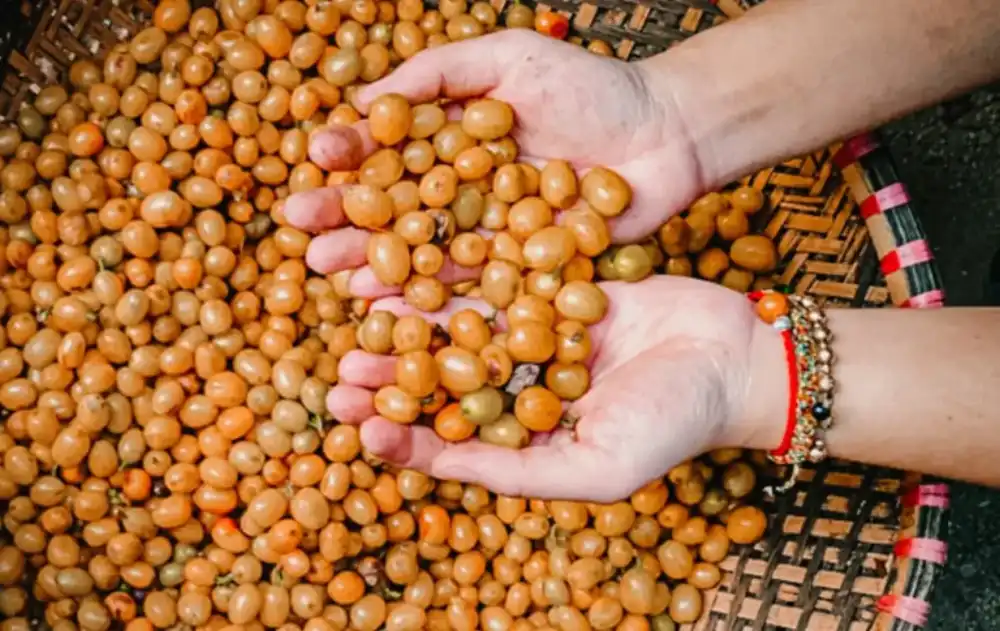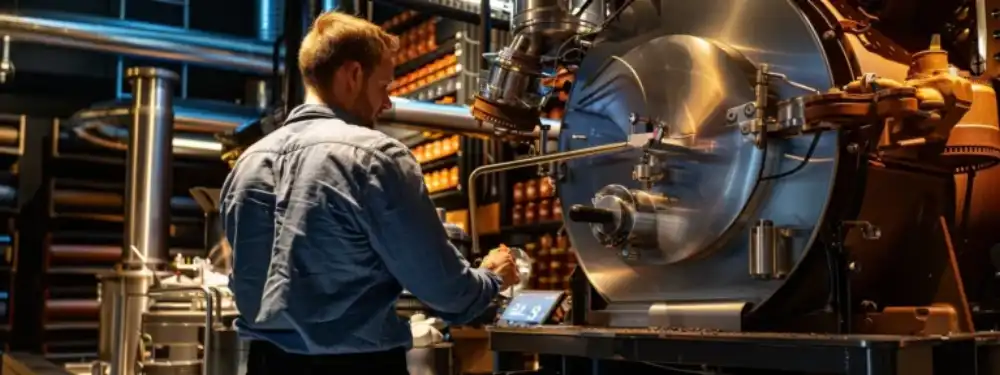Imagine the rich, earthy scent of freshly roasted coffee beans wafting through your neighborhood, the kind that evokes images of lush South American plantations where some of the finest coffee crops spring to life.
With our Valenta 18 Fluid Bed Coffee Roaster, you too can transform green coffee beans into the dark, aromatic jewels that make a velvety espresso so irresistibly delicious.
The process isn’t as intricate as one might assume; Coffee Crafters superior selection of USA made coffee roasters make it simple, from your business or home, you can play alchemist, turning raw beans into gold.
Keep reading for a clear, concise guide that’ll show you how to master the art of Green Bean Roasting–roasting coffee—one bean at a time.
Let Coffee Crafters Help You Become A Coffee Roaster

How to Roast Green Coffee in Your Valenta Coffee Roaster
Roasting your own green coffee beans at work or home can transform your daily brew into a crafted cup of excellence, with nuances ranging from delicate fruit undertones to rich chocolate depths.
Careful bean selection is fundamental, with varieties from Peru or Colombia offering distinct profiles that could flourish under the roasters’ unique roasting conditions.
Mastering timing and temperature settings is next on your journey, using your coffee roasters instrumentation to evoke optimal flavor and aroma without stepping into the realm of the over-roasted bean.
Observe the beans as they change from green to the shades of your preferred roast, attend to their color and scent with a keen sensory focus, as these clues indicate the progression to peak perfection.
Once achieved, prompt cooling is imperative to halt the cooking process, ensuring the volatile compounds that create enchanting aromas are preserved.
Finally, suitable storage practices safeguard the fruits of your labor, keeping your home-roasted coffee bursting with freshness until it’s time for brewing.
Preparing Your Coffee Roaster
Roasting endeavors begin with ensuring your coffee roaster is accurately configured and reaches the desired temperature, a crucial step in the coffee production process that profoundly influences flavor profiles. Beans sourced from the highlands of Africa or the lush regions of South America demand a steady heat that allows their unique characteristics, likened to the subtle sweetness of honey or the vibrant acidity of Burundi berries, to emerge beautifully.
Allow your small investment in a professional roaster from Coffee Crafters, to pay off rich dividends by providing real-time feedback, enabling adjustments that maintain the process within an ideal roasting spectrum and prevent the warmth from overshooting into bitter, charred territories.
Selecting the Right Green Beans for Oven Roasting
Embarking on your coffee roasting journey, consider New Guinea beans for their robust potential and subtle caramel hints that entice the palate.
Choosing beans certified as ‘fair trade’ not only contributes to ethical consumption but also ensures that your taste experience originates from the best coffee-growers dedicated to quality and sustainability.
Timing and Temperature Settings for Optimal Roasting
Roasting coffee as a hobbyist or professional demands a delicate balance; treat the beans as you would a fine patisserie, requiring precision and attention. When roasting varieties from the volcanic soils of Indonesia or the fertile lands of Costa Rica, a temperature range that starts at around 350 degrees Fahrenheit and climbs to approximately 450 degrees allows the beans to expand and the sugars to caramelize, achieving that rich, full-bodied cherry essence. Our coffee roasters come with a Co-Pilot option for a consistent roast, every time.
Typically, beans will take on a light roast within 10 to 12 minutes, while pushing beyond 15 minutes will edge them towards a darker, more intense profile – watch them closely to capture the precise moment of aromatic alchemy.
Checking Bean Color and Aroma for Desired Roast Level
Assessing the shade transition of the beans from grassy green to chocolatey brown is a silent dialogue between roaster and roast; it is about seeking that rich confectionary hue that hints at the perfect sugar development within. Whether sourced from the terraced fields of Ethiopia, the high altitude farms of Mexico, or the tropical climes of Sumatra, each origin embeds its plant’s signature that unfolds in color and scent under the heat.
Trust your senses as the roast deepens, embracing the warm toffee notes that waft from Ethiopian beans, or the chocolate and spice-infused aroma arising from those of Mexican lineage. Be ever-attentive to the Sumatran batches, for their earthy complexities are tenderly revealed as the beans’ texture evolves to a delicate sheen, foretelling a brew rich with the soil’s lush life.
Cooling the Beans After Roasting
Immediately after the roasting session, the green beans now turned fragrant with roasting, must be cooled quickly to stop the cooking process. Seeds from Brazil’s sultry coffee farms, in particular, contain delicate oils that can overdevelop if cooling is delayed, leading to an unintended bitter aftertaste.
In the diverse climate of Asia, where the coffee bean benefits from a tapestry of flavors, rapid cooling becomes even more essential. Spreading the beans out on a baking sheet allows the ambient air to swiftly dissipate the residual heat, thereby locking in the desired taste profile from bean to final cup.
Storing Your Professionally Roasted Coffee Beans
Post-roast, the key to storage lies in an airtight container or bag to retain their distinct low-acid profiles. Also, try to avoid storing your roasted coffee beans in direct sunlight and away from moisture that could dampen their vibrancy.
Consider Kenyan beans, revered for their bright acidity and bold flavors; these freshly roasted beans are sensitive to their environment. Ensuring they’re stowed in cool, dark places stabilizes their complex characteristics, protecting the investment of time and care poured into the roasting process, and guarantees each cup brims with the geography of its origins.
How to Roast Green Coffee in Your Oven
Embarking on the adventure of oven-roasting green coffee begins with collecting the right tools and beans.
You’ll need to fill your cart with unroished seeds hailing from the heart of Guatemala’s volcanic regions, known for their intricate sweetness, or from the fertile slopes of Tanzania, each bearing the promise of a lively cup.
With tools and Tanzanian or Guatemalan treasures on hand, you’ll preheat your oven and lay out your roasting tray, arranging the beans carefully to ensure they brown evenly.
Bestowing attentive care upon the beans as they roast, you will guide them through a spectrum of shades to achieve your desired depth of roast, from the light sun-kiss of the bean’s exterior to the profound, dark hue that whispers of hidden depths.
Listen for the tell-tale cracks, signifying milestones in the roasting process, and develop an intuition for distinguishing the subtle ‘first crack’ from the more assertive ‘second crack.’
Once your auditory cues signal completion, you’ll promptly cool your aromatic batch to preserve its richness, then leave the beans to degas, further solidifying their flavor profile, ensuring your oven efforts result in splendid brews.
Gather Necessary Equipment and Green Coffee Beans
Before embarking on the roasting journey, assemble the appropriate gear, starting with a high-grade oven thermometer to closely monitor the heat. Next, lay your hands on a selection of green coffee beans; Peaberry varietals from regions like Honduras stand out for their rounded, concentrated flavors that shift beautifully when kissed by the oven’s warmth, contrasting with the gentle hum of caffeine that perks the senses like an afternoon tea in Guinea.
Secure a heavy-duty roasting pan, essential for accommodating the beans in a single layer, ensuring they receive an even roast. As you select beans, consider the unique characteristics imparted by their homeland; Honduras offers richness akin to a robust tea, while Guinea suggests vibrant, caffeine-laden brews, and the prized Peaberry—a singular, rounded seed brimming with potential—awaits your transformative touch.
Preheat Your Oven and Prepare Your Roasting Tray
Initiate the alchemy of home roasting by setting your oven’s temperature to the ideal starting point, typically between 350 and 400 degrees Fahrenheit for a balanced roast. Proper heat regulation is the secret behind drawing out the subtle flavors embedded in beans from tropical regions like El Salvador, with its promise of luscious citrus and mild caramel notes.
Simultaneously, arrange a roasting tray by placing the El Salvador green beans in an even layer, ensuring none overlap. This setup is pivotal for achieving a uniform roast, allowing each bean to dance in the oven’s heat, ensuring all surface areas are evenly caressed to coax out the deep, velvety flavors characteristic of these Central American gems.
Spread Beans Evenly on the Tray for Uniform Roasting
Ensuring each green bean has its own space on the tray is akin to granting it an individual stage upon which to perform beneath the oven’s glow. Avoid clusters that may lead to uneven roasting; instead, give them ample room to expand and crack, essential for a consistent flavor profile across the batch.
By spreading the raw beans in a solitary layer, you allow heat to envelop each bean evenly, promoting a uniform transformation. This meticulous arrangement is the unsung hero of the roasting process, setting the stage for a symphony of taste in every cup.
Roast to Your Preferred Level: Light, Medium, or Dark
As the beans undergo their thermal journey, opt for the light roast if a tea-like delicacy emblematic of Ethiopian beans is what pleases your palate. A mere ten to twelve minutes in the oven should suffice, allowing beans to barely reach the first crack, a stage where the inherent bright and fruity notes are most prominent.
Should your taste incline towards the rich, complex flavors reminiscent of Sumatran coffee, consider edging towards a medium or dark roast. Allowing the beans to bathe in the heat for fifteen to twenty minutes will encourage them to reveal deeper layers of caramel and cocoa, exuding an aroma that fills the kitchen with anticipation of a robust cup.
Learn to Recognize First and Second Cracks
Attuning your ear to the distinctive sounds of first and second cracks marks a pivotal step in the roasting process, these audibles are indicators of stages crucial to flavor development. The first crack, a gentle popping reminiscent of twigs snapping in a low fire, signals the start of the light roast stage. As roasting progresses, listening for this soft symphony ensures you catch the initial transformation where delicate floral and fruity notes emerge.
Advancing from the first to the second crack ushers in the realm of medium to dark roasts, where sounds become more pronounced and rhythmic, similar to a hearty popcorn popper. Accurate timing in response to these cracks separates the wheat from the chaff in terms of achieving the desired roast – too soon, and the beans may lack complexity; too late, and you invite a bitterness that overshadows subtle nuances.
Post-Roasting: Cooling and Degassing Your Beans
Upon completing the roasting phase, the beans should be cooled without delay. A swift action here is key; it will stabilize the complex compounds that contribute to the bean’s flavor and aroma profile. Spread the beans on a baking sheet to expedite heat release and prevent further roasting from residual heat.
After cooling, the beans enter a critical resting phase called degassing. During this period, which can last up to 48 hours, carbon dioxide escapes from the beans. This natural process is fundamental as it primes the beans for grinding and brewing, ensuring the ultimate freshness and true character of your home-roasted coffee.
Mastering oven temperature control and precise timing is vital to turning green beans into aromatic masterpieces, reflecting the flavors of their exotic origins.
Observing color and scent closely guides you to the peak roast level, capturing the essence of each bean’s unique profile.
Rapid cooling post-roast is crucial in preserving the delicate balance of flavors by halting the cooking process.
Proper storage after the roast protects your coffee’s vibrant taste, ensuring a superior home-brewed experience with each cup.
Let Coffee Crafters Help You Become A Coffee Roaster

New To Coffee Roasting?
Let your first coffee roasting experience be with our Valenta 3. This fluid bed roaster is perfect for the home coffee enthusiast, the new home based coffee roaster and small commercial coffee operation. Coffee Crafters quality roasters are design and manufactured in the USA. Please reach out with any questions. If you would like to figure out which coffee roaster is the perfect fit for your roasting needs, check out our new ROI Coffee Roasting Calculator.








